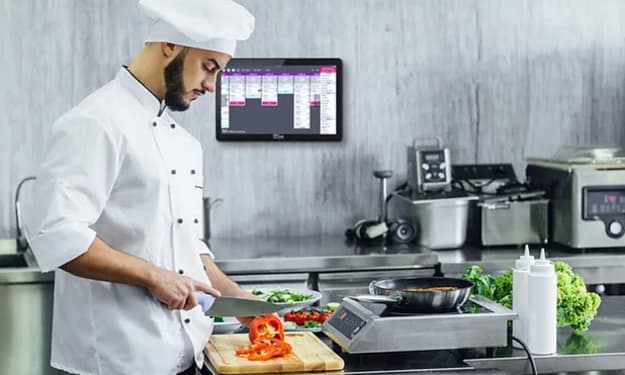
In today's highly competitive restaurant industry, efficient operations are crucial for success. One of the key tools that can significantly improve efficiency is a Point of Sale (POS) eco-system. It is a comprehensive software solution that streamlines various aspects of restaurant management, including order processing, inventory management, employee scheduling, and customer relationship management. By implementing a robust POS system, restaurant owners and managers can optimize their operations, enhance guest experience, and ultimately drive profitability.
Streamlining Order Processing with a POS System - A well-designed point-of-sale ecosystem can revolutionize the way restaurants process orders. With a few taps on a touchscreen device, servers can quickly input guests' orders, which are then instantly transmitted to the kitchen. This eliminates the need for paper tickets and minimizes the chances of errors or miscommunications. Additionally, a POS system can integrate seamlessly with other devices, such as kitchen display systems and printers, ensuring a smooth flow of information and timely order fulfillment.
Enhancing Inventory Management and Cost Control - Inventory management is another critical aspect of restaurant operations that can be optimized with a POS system. By accurately tracking ingredient usage and automatically updating inventory levels in real-time, a POS system helps minimize waste, prevent stockouts, and control costs. Furthermore, advanced POS systems can generate detailed reports and analytics, providing valuable insights into sales trends, popular menu items, and supplier performance. Armed with this information, restaurant owners can make data-driven decisions to optimize their menu offerings, negotiate better deals with suppliers, and identify opportunities for cost savings.
Improving Staff Efficiency and Productivity - Efficient staff management is essential for delivering exceptional customer service and maximizing productivity. A POS system simplifies employee scheduling, allowing managers to create and adjust shifts effortlessly. Staff members can access their schedules remotely, reducing the chances of scheduling conflicts or misunderstandings. Moreover, a POS system can track employee performance metrics, such as sales numbers and average order processing time, enabling managers to identify top performers and areas for improvement. By streamlining staff management, a POS system empowers restaurant owners to build a highly efficient and motivated workforce.
Strengthening Customer Relationship Management - In today's digital age, building and nurturing customer relationships is paramount. A POS system offers valuable tools to enhance customer relationship management (CRM) efforts. It can capture customer data during the ordering process, such as email addresses and phone numbers, enabling restaurants to build a robust guest database. This information can be leveraged for targeted marketing campaigns, personalized promotions, and loyalty programs. Additionally, a POS system can store order histories, allowing servers to provide a more personalized and attentive dining experience. By prioritizing guest satisfaction through effective CRM strategies, restaurants can foster customer loyalty and generate positive word-of-mouth.
The Importance of Choosing the Right POS System - While the benefits of a POS system for restaurant operations are undeniable, it is crucial to select the right system that aligns with the unique needs of the establishment. Here are a few key considerations when choosing a restaurant point of sale system:
1. Scalability and Customization - A POS system should be able to accommodate the restaurant's current needs while allowing for future growth. It should offer customizable features and configurations to meet specific requirements, such as table management, split-check capabilities, and integration with third-party applications.
2. User-Friendliness and Training - The system should be intuitive and easy to use, requiring minimal training for staff members. A well-designed interface with clear instructions and visual cues can significantly reduce errors and streamline operations.
3. Security and Data Protection - As a POS system handles sensitive customer information, robust security measures are essential. Look for systems that offer data encryption, secure payment processing, and regular software updates to protect against cybersecurity threats.
4. Integration and Compatibility - Ensure that the chosen POS system integrates seamlessly with other restaurant technologies, such as accounting software, online ordering platforms, and loyalty programs. Compatibility with hardware devices, such as tablets, terminals, and receipt printers, is also critical.
5. Customer Support and Maintenance - Select a POS system from a reputable provider that offers reliable customer support and regular maintenance. Timely assistance and software updates are crucial to keep the system running smoothly and address any technical issues promptly.
Conclusion
In today's fast-paced restaurant industry, optimizing operations is vital for success. A well-implemented point-of-sale ecosystem can transform the way restaurants handle order processing, manage inventory, schedule staff, and nurture customer relationships. By streamlining these critical aspects of restaurant management, owners and managers can improve efficiency, reduce costs, and deliver exceptional dining experiences. When choosing a POS system, it is essential to consider factors such as scalability, user-friendliness, security, integration, and customer support. By harnessing the power of a robust POS system, restaurants can stay ahead of the competition and thrive in the digital era.






Comments
There are no comments for this story
Be the first to respond and start the conversation.